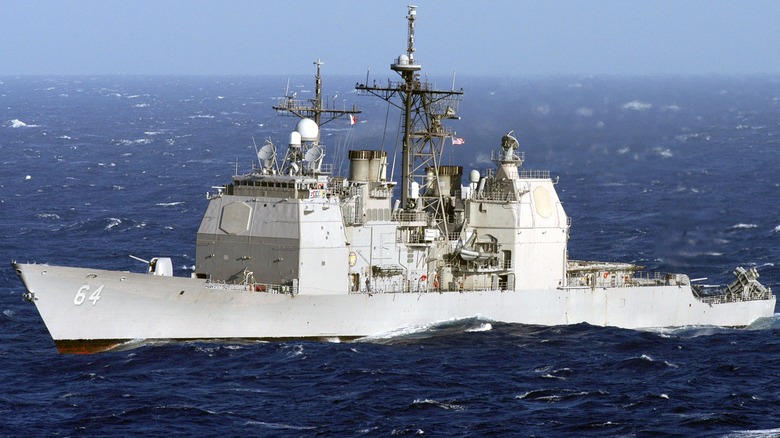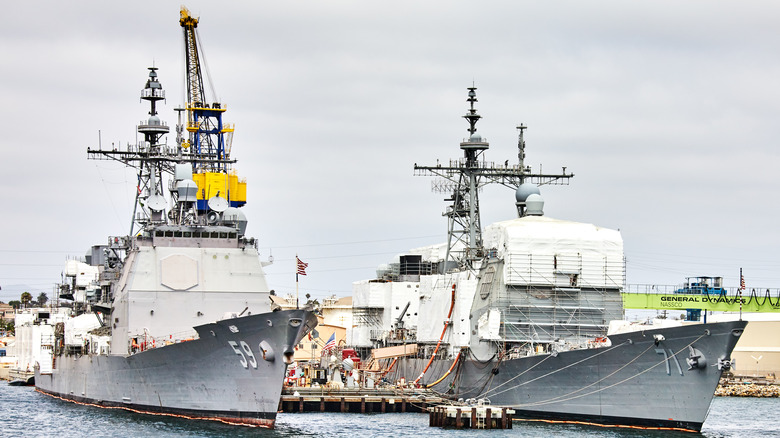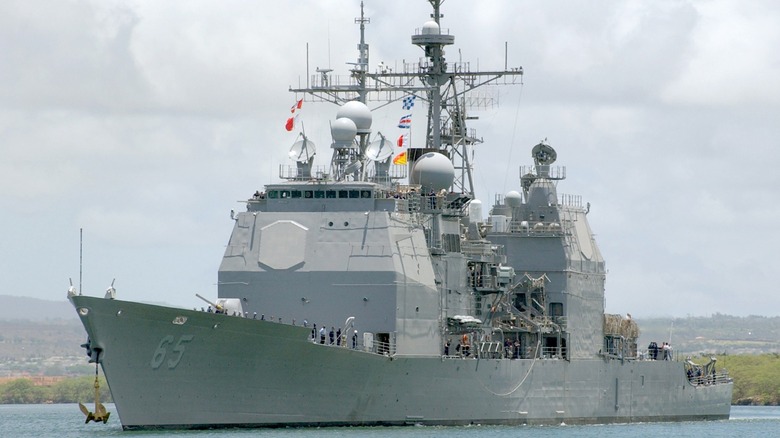Everything Wrong With The Navy's Cruiser Modernization Program
When the U.S. Navy commissions a new warship, it's not typically at a low cost to American taxpayers. Modern military vessels are incredibly complex machines featuring millions of moving parts, weapon systems, radars, and everything else that can be packed into a ship. To keep them operating as long as possible, the Navy routinely undergoes modernization programs to bring its aging fleet of warships up to speed for modern military requirements. This is cheaper than scuttling existing vessels for entirely new ones.
But modernization programs don't always go according to plan, and the Navy's cruiser modernization program is an excellent example of this. The program has been incredibly wasteful and poorly run, creating numerous learned for the Navy's destroyer modernization program.
Cruisers, one of seven types of modern warships, are used for a variety of missions. The U.S. currently operates a single type, the Ticonderoga class. There were 12 active Ticonderoga-class cruisers in the active duty Navy prior to modernization, many commissioned in the 1980s and '90s, so modernization was needed to keep them relevant. The cruiser modernization program began in 2017 with the intention of modernizing 11 ships.
But after spending nearly $4 billion to modernize seven over the past decade, the U.S. Government Accountability Office says, only three will come through to the other side. Despite the effort, they won't gain an extra five years of service life as intended, making most of the money spent a waste.
The Ticonderoga-class cruiser
Ticonderoga-class cruisers first entered service in the early 1980s via the USS Ticonderoga (CG-47). Modern versions feature a Mark 41 vertical missile-launch system and function as guided-missile cruisers. They cost around $1 billion to construct, and they're powered via four General Electric LM2500 gas turbine engines, for a total of 80,000 shaft horsepower. This lets a Ticonderoga-class cruiser reach speeds over 34 mph.
Ticonderoga-class cruisers measure 567 feet long with a beam of 55 feet, and they displace 9,800 tons of seawater. They're crewed by 30 officers and 300 enlisted personnel, and each vessel can accommodate two SH-60 Seahawk helicopters, one of the many variants of the UH-60 Black Hawk. Their armament features the aforementioned launch system, which can fire Tomahawk Cruise Missiles and others from its 122 missile storage and launching tubes. On top of those, each vessel is armed with six Mark-46, -50 or -54 torpedoes, two Mark-45 54-caliber guns, two Phalanx cannons, and more for defense.
The cruisers have been under scrutiny for years, with many on tap to be decommissioned prior to their 35-year lifecycle coming to an end. Part of the reason for this is the modernization program, which didn't help extend their life as planned. The Navy planned to replace Ticonderoga-class cruisers and Arleigh Burke-class destroyers with the DDG(X) Next-Generation Guided-Missile Destroyer, but these won't be ready to enter the force until 2032 — and that's if everything goes according to plan, which it rarely does in military procurement.
What went wrong with the Navy's cruiser modernization program
The purpose of the modernization program was to extend the fleet's life without having to replace ship. This should have worked out well, but according to the Government Accountability Office, weak oversight and a lack of quality-control tools resulted in the wasteful spending of $1.84 billion — nearly half of the program's cost. "For example," the GAO said, "leadership discouraged the use of monetary penalties, so contractors weren't always held accountable for their late and sometimes poor-quality work."
Four of the planned 11 cruisers were removed from the modernization plan, setting them up for retirement. Four of the seven that went through the process were decommissioned, which is where the $1.84 billion was wasted. Only three — the USS Gettysburg, USS Chosin, and USS Cape St. George — will complete the program and reenter service. That cost a total of $1.9 billion, but because those ships' service life wasn't extended, that money was also largely wasted.
One of the biggest reasons for the failure of the cruiser modernization program was that it was poorly planned. This resulted in over 9,000 contract changes, which ballooned costs and upended the schedule. And leadership-led inspections dropped by nearly 50%, which didn't help matters. The Navy and GAO are studying the issue to determine what can be done, and what shouldn't be repeated, as plans begin for modernizing the fleet's destroyers, which are among the most powerful navy destroyers in the world.


